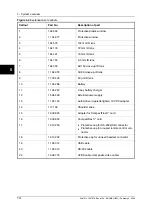
The more the IR camera operator knows about the equipment that he or she is about
to inspect, the higher the quality of the inspection. But it is virtually impossible for an
IR thermographer to have detailed knowledge about all the different types of equipment
that can be controlled. It is therefore common practice that a person responsible for
the equipment is present during the inspection.
7.2.3
Inspection
The preparation of the inspection should include the choice of the right type of report.
It is often necessary to use complementary equipment such as ampere meters in order
to measure the current in the circuits where defects were found. An anemometer is
necessary if you want to measure the wind speed at inspection of outdoor equipment.
Automatic functions help the IR operator to visualize an IR image of the components
with the right contrast to allow easy identification of a fault or a hot spot. It is almost
impossible to miss a hot spot on a scanned component. A measurement function will
also automatically display the hottest spot within an area in the image or the difference
between the maximum temperature in the chosen area and a reference, which can
be chosen by the operator, for example the ambient temperature.
10712703;a3
Figure 7.1 An infrared and a visual image of a power line isolator
When the fault is clearly identified and the IR thermographer has made sure that it is
not a reflection or a naturally occurring hot spot, the collection of the data starts, which
will allow the correct reporting of the fault. The emissivity, the identification of the
component, and the actual working conditions, together with the measured tempera-
ture, will be used in the report. In order to make it easy to identify the component a
visual photo of the defect is often taken.
7.2.4
Classification & reporting
Reporting has traditionally been the most time-consuming part of the IR survey. A
one-day inspection could result in one or two days’ work to report and classify the
found defects. This is still the case for many thermographers, who have chosen not
to use the advantages that computers and modern reporting software have brought
to IR condition monitoring.
7
Publ. No. 1557978 Rev. a155 – ENGLISH (EN) – February 6, 2006
19
7 – Introduction to thermographic inspections of electrical installations
Содержание ThermaCam P25
Страница 2: ......
Страница 4: ......
Страница 6: ......
Страница 7: ...ThermaCAM P25 User s manual Publ No 1557978 Rev a155 ENGLISH EN February 6 2006...
Страница 10: ...Reg No Status Designation 29 233 400 Pending U S x Publ No 1557978 Rev a155 ENGLISH EN February 6 2006...
Страница 16: ...INTENTIONALLY LEFT BLANK 1 2 Publ No 1557978 Rev a155 ENGLISH EN February 6 2006 1 Warnings cautions...
Страница 26: ...INTENTIONALLY LEFT BLANK 4 12 Publ No 1557978 Rev a155 ENGLISH EN February 6 2006 4 Packing list...
Страница 66: ...INTENTIONALLY LEFT BLANK 8 52 Publ No 1557978 Rev a155 ENGLISH EN February 6 2006 8 Tutorials...
Страница 78: ...INTENTIONALLY LEFT BLANK 9 64 Publ No 1557978 Rev a155 ENGLISH EN February 6 2006 9 Camera overview...
Страница 98: ...INTENTIONALLY LEFT BLANK 11 84 Publ No 1557978 Rev a155 ENGLISH EN February 6 2006 11 Folder and file structure...
Страница 104: ...INTENTIONALLY LEFT BLANK 12 90 Publ No 1557978 Rev a155 ENGLISH EN February 6 2006 12 Electrical power system...
Страница 108: ...INTENTIONALLY LEFT BLANK 14 94 Publ No 1557978 Rev a155 ENGLISH EN February 6 2006 14 Maintenance cleaning...
Страница 158: ...INTENTIONALLY LEFT BLANK 20 144 Publ No 1557978 Rev a155 ENGLISH EN February 6 2006 20 Theory of thermography...
Страница 191: ......






























